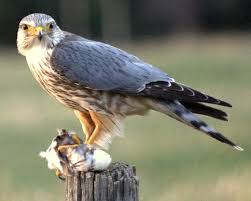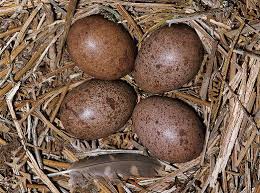Was it a Merlin, the smallest member of the falcon family, or did I see something else?

Falcons have long, pointed wings and fly with strong, rapid wing-strokes. Hawks have rounded wings and in flight alternate between several rapid wing-beats and a short glide. As a result, even before I left primary school in the UK, I could recognize a kestrel from a sparrow hawk. Both species were common around the farms on which I lived. Kestrels would hover above me, waiting to catch their prey, whereas sparrow hawks would fly by, low and fast, in pursuit of some unfortunate bird. And then one day at school, I had the opportunity to trade a yellowhammer’s egg and one from a tree pipit for a rusty brown egg, about the size of a wood pigeon’s egg, and was told the egg belonged to merlins. My school friend claimed it was a taken from a nearby nest, and the exchange took place only weeks before the 1954 British law forbidding egg collecting was implemented.
 European kestrel
European kestrel
 Sparrow hawk
Sparrow hawk
My friend assured me the merlin was nesting in a tree close to his home and was using an abandoned crow’s nest for its purposes. He invited me to come and look at it at a place called Redhouse Wood, near to the River Ouse on the west side of York. The wood itself was largely coniferous. I saw the nest and I tried to convince myself that I spotted the parent. The problem was, back then, in the early 1950s, there were only a few merlins nesting in Britain, and the nearest one should have been miles away on the North York Moors. These are supposedly ground nesting birds in the UK, and only appear on the lowlands during winter. Nonetheless, the egg looked very much like a merlin’s according to the illustration in my Bird Book. Some of my earliest early bird watching experiences are included in more detail in the early chapters of my most recent novel She Wore a Yellow Dress. This particular story is referenced in chapter one, titled The Abandoned Cuckoo.
Historically, during the Middle Ages, the merlin was the falcon of choice for important European noblewomen such as Catherine the Great and Mary Queen of Scots, and nicknamed the “lady hawk”. It was used in their sport of hunting skylarks. Even today, some merlins are kept in captivity and are bred to hunt small birds. They fly fast, just a few feet above the ground, in pursuit of songbirds on the wing, and utilize their speed and element of surprise.
 Merlin eggs
Merlin eggs
Merlins are small, fierce falcons, preying on birds ranging in size from sparrows to quail. It is the smallest falcon in the UK, but in North America, where it is colloquially named the “pigeon hawk”, it is slightly larger than the American kestrel. The male merlin has a slate-gray back and underparts that range from buff to orange-tinted and streaked with black to reddish brown. The female is brownish-gray above, with whitish below spotted in brown. Today there are approximately 1300 breeding pairs in Britain. While their population in my early days of bird watching was fairly stable, despite being persecuted by landowners, their numbers were subsequently reduced significantly by the introduction of agricultural pesticides. As these chemicals are now banned, and new laws protect the bird and its eggs, the population has increased.
I had to wait until I arrived in California to see my first authenticated merlin. Here the species are winter visitors and can be observed along the Marin Headlands in Northern California. More recently, I thought I had spotted a merlin sitting on a branch a couple of feet above my bird feeder, but on closer inspection, it turned out to be a sharp-shinned hawk. In North America the population of merlins is estimated to be around 1.6 million, and 3.2 million worldwide. They have an extremely broad geographic range and are present across all of North America, Europe and Asia. Many migrate for winter, as far south as South America, and to Southern Europe and North Africa. In Europe, the UK is on the southern edge of the merlins’ European breeding range.

Merlin range map (yellow: breeding/ blue: winter)
Land use change is their greatest threat, especially in their breeding areas, but the species seems willing to adapt and live wherever there is sufficient food and nesting opportunities. Britain considers the merlin an “endangered” species, especially because of global warming that is likely to push the breeding range northwards, with only the Scottish Highlands remaining a refuge for the bird. It has been added to the Red List of birds facing severe decline and in need of urgent conservation action.
In the United States, it is classified as of “Least Concern”, with its population stable. Here the species is expanding its breeding range south for unclear reasons, and adapting to live in urban and suburban areas so long as there is a food supply and the space to chase down its prey. A merlin will eat as many as 900 birds each year. It may also be following crows that increasingly rely on human habitation for protection and food, and when they abandon their nests, the merlin quickly makes use of them.
I will never know if I truly saw a merlin back in the early 1950s but I still have the egg in my birds’ egg collection. However, it is embarrassing to think that back then I would take birds’ eggs and trade them at school, and give no thought to the consequences.




My father took some good photos of a merlin with its nestlings in Caithness in July 1934, which I would happliy share with you if you are interested.. He was an early member of the BTO , developing his interest in ornithology at Oxford. James Fisher was a close friend
This winter in lowland Herefordshire and Worcestershire (farmland within 5-8 miles of upland) I’ve regularly seen 2 male merlins- unmistakable falcon wings, flying very low along hedged country lanes and ditches (as I drive behind them) .. always diverting off the road eventually with a few very sharp 90° degree turns up and over into fields .. (note: nothing like kestrel behaviour) .. I have a feeling they are more common these days and are breeding in the Welsh mountains and Shropshire hills, where there are still skylarks aplenty